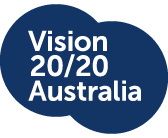MEDIA RELEASE
Vision 2020 Australia, in collaboration with 14 organisations working in Aboriginal and Torres Strait Islander eye health, has launched a proposal calling on the Australian Government to build on its commitment to close the gap in eye health and vision care.
Closing the Gap in Eye Health and Vision Care by 2020, sent directly to key Australian Government representatives, sets out program and implementation priorities endorsed by the eye health and vision care sector.
It builds on Vision 2020 Australia’s successful first proposal in 2015, which saw measures such as the Australian Institute of Health and Welfare’s Indigenous eye health report introduced.
Carla Northam, CEO of Vision 2020 Australia, says: ‘While a focus on Indigenous eye health and vision care has seen the gap in rates of blindness halved, Aboriginal and Torres Strait Islander people remain three times more likely to be blind or vision impaired than the broader population.
‘Closing the Gap in Eye Health and Vision Care by 2020 calls for continued and targeted efforts to ensure equity in eye health and vision care for Aboriginal and Torres Strait Islander people.’
The proposal sets out key priorities, for implementation by the Australian Government, stating that:
- targeted investment in coordination, both at a regional level and on the ground is crucial to support frontline service delivery and ensure that patient pathways of care are efficient and effectively managed
- improved availability of, and access to, culturally aware and culturally safe eye health and vision care services is critical to ensuring equitable outcomes and reducing high rates of avoidable blindness and vision loss among Aboriginal and Torres Strait Islander people
- nationally consistent subsidised spectacle schemes to address uncorrected refractive error are essential to ensure improved access to prescription glasses among Aboriginal and Torres Strait Islander communities
- a nationally coordinated approach to the full implementation of the World Health Organisation’s SAFE Strategy is required to achieve the elimination of trachoma by 2020
- national oversight and consistent data is essential to ensure accountability and system-wide strategic direction for Aboriginal and Torres Strait Islander eye health and vision care services in Australia.
Ms Northam says: ‘The Indigenous health sector, including eye health and vision care, has a long history of collaboration and using its collective expertise to strengthen health care systems.
‘Government support, particularly through investment and policy change, is a vital component to improving health outcomes for Aboriginal and Torres Strait Islander people.
‘Implementation of the 12 recommendations in this proposal will ensure continued progress towards closing the gap for eye health and vision care by 2020.’
Download Closing the Gap in Eye Health and Vision Care by 2020.
ENDS
For more information: Adam Sawell at Vision 2020 Australia
03 9656 2020, 0401 096 507 or asawell@vision2020australia.org.au
About Vision 2020 Australia
As the national peak body for the eye health and vision care sector, Vision 2020 Australia represents almost 50 member organisations involved in: local and global eye care; health promotion; low vision support; vision rehabilitation; eye research; professional assistance; and community support. Established in October 2000, Vision 2020 Australia is part of VISION 2020: The Right to Sight, a global initiative of the World Health Organisation and the International Agency for the Prevention of Blindness.
